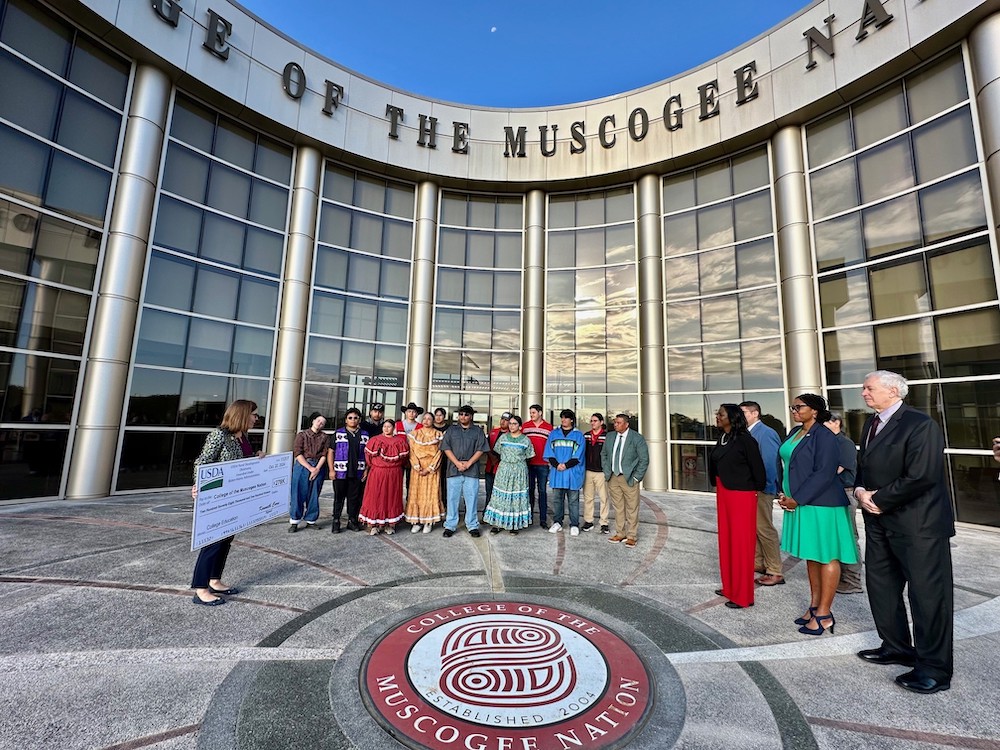
- Details
- By Chez Oxendine
- Food | Agriculture
The number of Native American farmers continues to decrease as more farmers retire and fewer young farmers step in to take their place.
According to the last Department of Agriculture Census, held in 2022, the number of Native American producers fell 1% to 78,300 between 2017 and 2022. The number of farms run by Native producers fell 3% — from roughly 60,100 to 58,000.
To address the decline and foster a new generation of Native farmers through improved access to agricultural education and career paths, the Department of Agriculture has announced an array of new programs, including $5 million in direct funding to land-grant colleges, to support and retain tribal students in higher education.
 (L-R) : Jacobs-Young, RandallThe new initiatives aim to improve USDA’s integration with tribal education, according to Dr. Chavonda Jacobs-Young, the department’s under secretary for research, education, and economics (REE), as well as chief scientist. Tribal agriculture makes a broad impact on the wider agricultural landscape of the United States, Jacobs-Young said. The sector controls 7.2% of the country’s farm land and sold $6.2 billion in products across 2022, according to the last USDA census.
(L-R) : Jacobs-Young, RandallThe new initiatives aim to improve USDA’s integration with tribal education, according to Dr. Chavonda Jacobs-Young, the department’s under secretary for research, education, and economics (REE), as well as chief scientist. Tribal agriculture makes a broad impact on the wider agricultural landscape of the United States, Jacobs-Young said. The sector controls 7.2% of the country’s farm land and sold $6.2 billion in products across 2022, according to the last USDA census.
“This partnership with the tribal colleges and the communities that they serve is critically important to how we move forward,” Jacobs-Young told Tribal Business News. “It's through these partnerships that we make continuous investments into tribal youth, and through those investments, we can help tribal agriculture thrive.”
Beginning in fall 2025, the USDA’s tribal scholars program will provide full tuition, fees, books, and paid workforce training to students pursuing degrees in agriculture, food, natural resource sciences, or related disciplines at a tribal college or university. Students who graduate will be offered fast-track opportunities for careers at the USDA. The program timeframe begins fall 2025 and the application deadline is January 31, 2025.
The New Beginning for Tribal Students program will award $5 million across 15 institutions to widen those schools’ support for tribal students, aiming to improve retention and graduation rates.
Additionally, faculty and staff at tribal colleges and universities are invited to apply for the Terra Preta do Indio Tribal Fellowship program, which will launch a summer 2025 cohort that will work closely with USDA program leads to identify potential collaborations and research. The application deadline is December 30, 2024.
Dr. Monte Randall (Muscogee Nation),the president of the College of the Muscogee Nation (CMN), said the USDA’s newest slate of programs around tribal agricultural education represents an ongoing push to widen access and capacity at tribal colleges and universities.
Randall highlighted USDA support for CMN’s natural resources program, which has grown in the last six years thanks to USDA assistance, including a recent $278,000 grant to improve on-campus life for students. The support has enabled the college's extension growth through the National Institute of Food and Agriculture's Tribal Colleges Extension Grant Program. Through this support, CMN's extension program provides technical assistance and research for farmers and ranchers across the reservation's 11 counties in Oklahoma.
“We’ve seen a lot of support for that program in particular,” Randall said. “They’ve helped us improve those three areas of outreach, education, and research. We’ve benefited a lot from this partnership in trying to build this pipeline of farmers and ranchers.”
The knowledge exchange is mutual, Jacobs-Young said, as the USDA continues to adopt more Indigenous ecological knowledge across their grant programs and requests for proposals. This makes supporting research and expanding capacity at tribal colleges and universities increasingly important for the department.
The USDA now encourages applicants for grants across all their programs to include potential demonstrations of Indigenous ecological knowledge in proposals. The initiative complements ongoing efforts at the department to integrate Indigenous foods into food packages, and provide tribal governments more control over their food distribution programs, per prior Tribal Business News reporting.
“We're really trying to work to advance indigenous traditional ecological knowledge across all of our research projects, grants and funding opportunities and our education programs,” Jacobs-Young said. “We're really working to build trust and build partnerships so that we can work together to preserve these very special traditions.”
Randall said Indian Country was seeing those USDA engagements “really pay off.” He pointed to ongoing efforts to create seedbanks and promote traditional harvesting methods that improve sustainability and crop health - all stemming from Indigenous practices.
“I see the great work taking place,” Randall said. “These programs are focused on youth development, on responsibility, and on sharing the core values of our people - and the work that the USDA is doing is really helpful to us.”
In a statement provided to Tribal Business News, Agriculture Secretary Tom Vilsack said that was the goal.
“These USDA investments reinforce our commitment to empowering Tribal Nations by cultivating tomorrow’s agriculture sector professionals and building a USDA workforce more representative of America,” Vilsack said. “It is important that USDA continues to uplift Tribal communities and provides pathways of representation by working with universities and colleges to improve the lives of Native American students and communities through higher education.”
